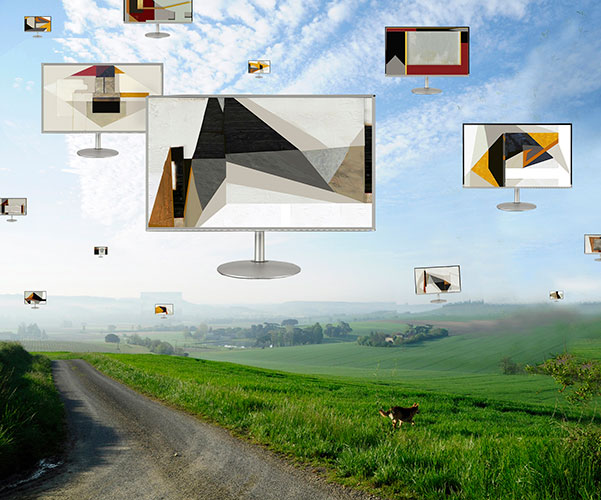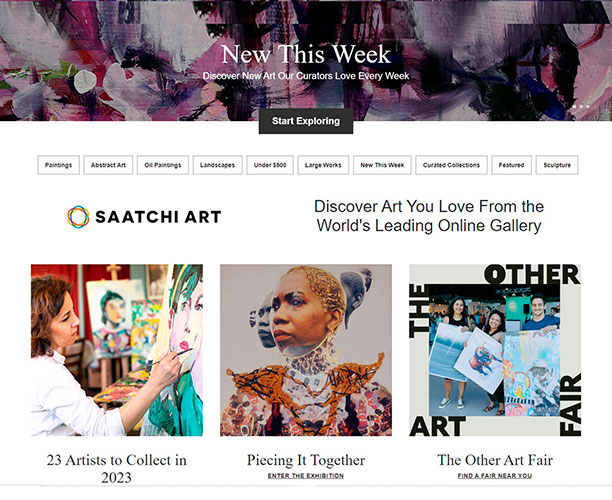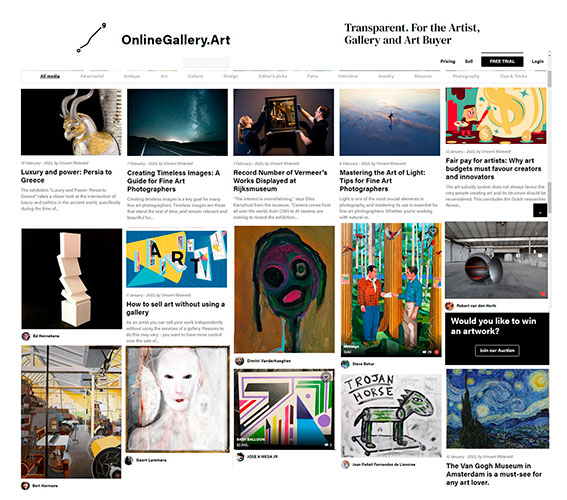Art, // February 26, 2023
IT’S RAINING ART, HALLELUJAH! -The online gallery and its possible contribution to the democratisation of the art scene.
What is an online gallery? (and what is not).
The online gallery differs from the traditional gallery primarily in that it has no “material” domicile. Of course, the company has to be registered somewhere, but it only exists digitally. This means no rental costs for exhibition space and storage, no expensive art fair stands, no elaborate vernissages. The running costs are thus lower than those of a normal gallery, which is reflected in the lower sales commission of the online gallery. Both artists and collectors benefit from this.
Since the online gallery does not have a real exhibition space, its customers buy the artworks without having seen them physically. This is less risky than it might seem at first glance. The photographic presentation is usually very extensive and of high quality. And as a last resort, many online galleries offer a return policy if the painting does not meet the buyer’s expectations.
Another essential difference is the number of artists under contract to the gallery. In primary sales, the classical gallery represents a limited number of about thirty to at most a hundred handpicked artists. In contrast, even a small online gallery can show at least a thousand artists, while the large portals can exhibit tens of thousands. The choice for the collector is much larger than at a traditional gallery.
The online gallery also differs significantly from the regionally based brick&mortar gallery in its geographical reach. Unlike the classical gallery, it reaches its audience worldwide without any special financial outlay and thus offers the collector a global selection of art, and the artist aworldwide forum for his work.
In summary, compared to the traditional gallery, the online gallery is more accessible to the collector, offers a much larger and more international selection, and is on average less expensive than the prevailing art market prices. Many online gallery owners therefore claim that they are committed to the democratisation of art by enabling a very large number of artists to make their works available to the public, while at the same time reducing threshold anxiety among buyers and reaching a wider clientele than would be possible for a traditional gallery.
What types of online galleries are there?
Basically, one must distinguish between two types of online galleries: the curated online gallery, which functions according to the classic principle of the middleman (gallery owner), and the “direct” online gallery, which places the emphasis on personal contact between artist and collector.
With the curated online gallery, the artist can open an account free of charge and design his or her own artist page. For each sale, the artist pays the gallery a commission, usually around 35 – 40%.
The direct online gallery, on the other hand, charges it’s artists a modest “rental fee” for the use of the portal. In return, the operator waives a sales commission. The proceeds of the sold artwork remain 100% with the artist. However, the artist has to take care of all sales modalities and the shipping of the artwork.
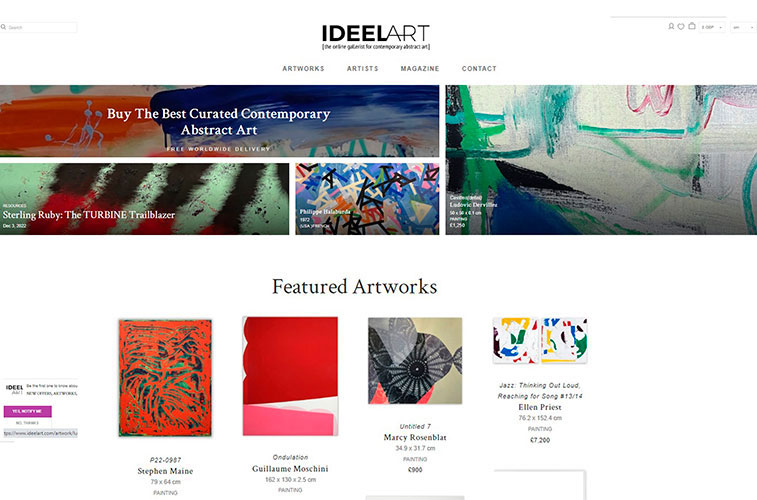
IDEEL ART, based in London, led by CEO and co-founder Christelle Thomas, is one of the rare online-galleries that does not count on versatility but spezialises exclusively on the promotion and sale of abstract painting. A must for collectors with a passion for abstract art!
How do you judge the quality of an online gallery?
For the curated online gallery, the question can be answered in the classical sense: a conventional gallery is as good as its galerist – and an online gallery is as good as its curators. If you are looking for artworks that will help shape the design and atmosphere of your home, express and/or enhance your attitude to life, touch and stimulate you emotionally and intellectually, and broaden your horizon, then your first step is to go to the “about us” page and there to the curators. Don’t believe in empty chatter about “our international curatorial team” or “our art director” etc. These exist only in the imagination of the provider. A professional curator is paid for his/her work, takes responsibility for it and of course wants to reap the deserved recognition. Serious online galleries therefor introduce both in-house and guest curators personally: with name, photo and detailed professional qualifications. You can safely forget everything else.
With the direct online gallery, professional advice is not typically available, and this form is therefore more suitable for experienced collectors who do not need advice, or adventurous spirits who want to make their own experiences and can cope with a possible mistake. The bonus is direct contact with the artist and possibly a lower price due to the omission of the gallery commission.
The question of transport must also be considered. While large online-galleries can negotiate affordable shipping costs, this is not always the case in individual shipping. Since transport is generally paid for by the art buyers, they would do well to find out in advance whether the shipping costs are included in the purchase price or whether there are still considerable additional costs to be expected.
Further criteria for the assessment of an online gallery are the presentation of the website and it’s technical functionality. A turgid presentation with black background, frames or mourning borders around the photos, veils over the banners and other superfluous bells and whistles should prompt caution at first glance. Gross technical deficiencies are also a red flag. If images cannot be loaded or deleted properly, filters and internal search engines do not work and texts can only be read in dadaistic translation, you should expect payment transactions and dispatch to be just as chaotic.
Legal aspects and the black cyber sheep.
Major scandals, as known from the traditional art scene, are not (yet) known in the digital field. Although the layman may mostly fear difficulties in payment transactions, most online galleries are reasonably well organised in this sector. Personally, I have never had any financial problems in fifteen years of working with a whole series of online galleries.
All the same, the collector will do well to protect himself as comprehensively as possible. A Certificate of Authenticity (COA) signed by the artist is therefore an essential part of the art purchase. In addition to the date of sale, the artist’s name and signature, it should also contain the title and year of origin of the work of art, the technique used, the dimensions and a photograph of the work. With the advent of blockchain security, the collector has another instrument at his disposal with which the provenance of the work of art can be proven in a forgery-proof manner.
In contrast, the aforementioned pretence of false facts in the curatorial field is almost a standard annoyance in the online art scene. If an online gallery explicitly claims that it only sells curated, i.e. professionally approved art, although it is run by a team with an exclusively technical or commercial background that does not have the professional competence to curate anything at all, this claim is rather questionable.
The artistic quality suffers accordingly. What is propagated by these galleries is mostly commercial art, i.e. the serial production of the same popular subject, which is produced by the artist in great quantity and speed. Popular subjects are, for example, maritime scenes, pretty girls or sugary abstracts.
Pictures «in the style of» also belong in this category. Bestsellers are second-hand Picassos, or works à la Lichtenstein (comic figures blown up to large format), Opalka (nicely coloured numbers or letters), and Hockney (swimming pools). It should be clear to the buyer that this imitation art, though absolutely legal, will never increase in value because it lacks the most important criterion for artistic quality: originality.
Probably the most common «trivial offence» of online galleries is the manipulation of search engines in the battle for digital visibility. For example, an online gallery has been posing for months as my «official» gallery that would sell my works «exclusively» – which was a brazen lie. As a result, potential buyers who typed my name into google were directed straight to this gallery, which got me into trouble with my other galleries and agencies, who – and rightly so – considered this unfair competition.
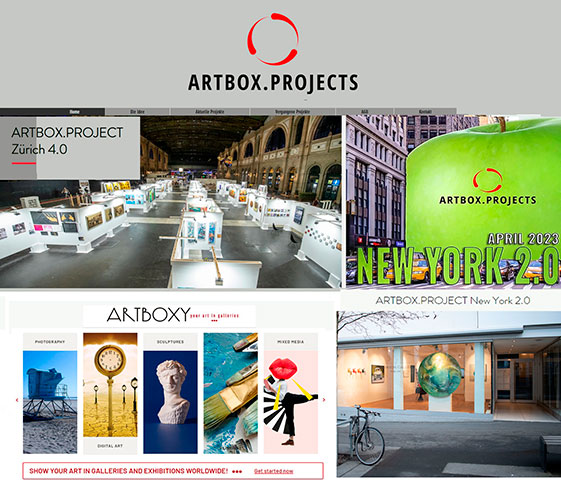
ARTBOX.GROUPS, based in Zug, Switzerland, offers an uniquely innovative hybrid programme by combining physical art exhibitions with digital presentations on large display screens, and organizing digital exhibitions in galleries and art fairs worldwide.
The future of the online gallery in the global art scene and its possible role in the democratisation process.
At a time when democracy is under attack from many sides, we have more reason than ever to think about the importance of culture for our democratic world order. But this also means that we must finally begin to denounce and fight corruption within our institutions.
Until deep into the twentieth century, 50% of all western artists fell victim to exclusion from the outset – namely all women. We will never know how many masterpieces have been lost to humanity because of the institutional macho maxim that women should limit their creativity to childbearing. But even male colleagues are not spared. If it had been up to the ruling cultural popes, the works of Vincent van Gogh, for example, would hardly have survived.
The dependence of the art market on toxic money, the elitist marketing of art as a status symbol, obscene auction prices for worthless junk, highly subsidised blockbuster events à la Disneyland, the supremacy of the big mainstream galleries and patrons and the resulting financial emergency of independent artists are only a few aspects of the unpleasant «state of the art». The call for a fair, democratic approach to art and artists is therefore more than justified – and long overdue.
There is broad agreement of what such a democratic cultural scene should look like. It should geopolitically guarantee more justice for artists and culture, give up its elitist ghetto, be made accessible to a larger audience and specifically integrated into everyday civic life, offer the artist more independence from conservative cultural institutions and a solid basic income, and be disconnected from toxic sponsors and money laundering. So much for the theory.
Opinions differ on how this should be implemented in practice. Many pilot projects are already in circulation. The Documenta 15, curated by the collective ruangrupa, certainly caused the greatest stir, as it failed, absurdly enough, because of racist prejudices – exactly the same, wellknown behavioural pattern that Kassel actually wanted to denounce.
Attempts to “popularise” art or turn it into a tourist attraction – Bosch as an animated film, Van Gogh as a kaleidoscope, pleasing Son-et-Lumière performances and similar antics – are likely to serve the cause only to a limited extent. It is true that this brings large crowds to the museums in the short term, but they are just as quickly gone again as soon as things get a bit more sophisticated. The lowest common denominator is never a good starting point – and certainly not in art.
That digital art as such will make the scene better is probably also wishful thinking. Of course the great artists of the metaverse are still to come. But whatever the future of digital art holds for us, it does not change the fundamental tension between producer (artist), distributor (museums, galleries) and consumer (museum visitors and collectors).
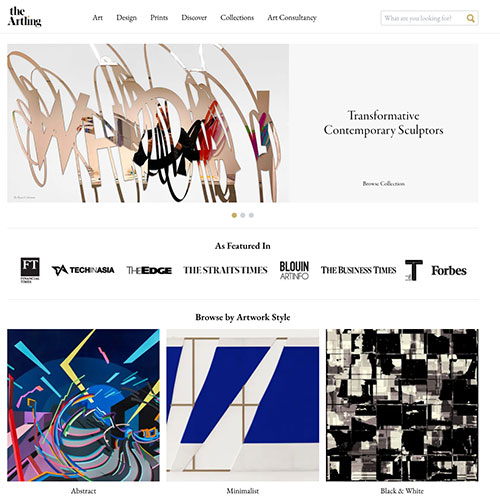
THE ARTLING is the leading online gallery in Asia, offering a carefully curated collection of contemporary art and design from over 3,500 international artists. Based in Singapore, the online gallery and art consultancy was founded by Talenia Phua Gajardo, formerly working for Zaha Hadid Architects in London.
It is within this framework, then, that the phenomenon of the online gallery and its possible future should be seen. Indeed, it fulfils many democratic demands: It offers access to the art market to a very large number of artists of all nationalities and is at the same time directly accessible to a global audience. In terms of price, it is still far below the traditional market. Above all, it focuses on openness – for all nationalities, ideologies and gender orientations. The direct form of the online gallery goes one step further and wants to bypass our ailing cultural system by dispensing with middlemen and curators altogether and relying on the subjectivity of art.
Whether the art business can manage without experts rests still to be seen. Democratic art means: art for all, and not: junk for all. We should stick to that. Nevertheless, in my eyes, the direct online gallery is the most promising variant of art mediation for the future, because it is the only one that fundamentally questions the power structures of the current art scene. If it manages to ally itself with a new generation of experts who do not want to parasitically enrich themselves or make a name for themselves at the expense of the artists, but rather put their knowledge at the service of culture and society, then we could finally begin to talk seriously about democratic art.
Even if the future belongs to the online gallery, we will not want to do without the physical presentation of art. It can therefore be assumed that hybrid forms of art trade will develop in the medium term, in which case one can only optimistically hope that the best of both worlds will prevail. Even if it is often forgotten: Art and culture are not speculation commodities for the rich, but an organic component of our democratic society. It is high time that it is finally perceived as such.
© VAS Juliet Vles
Read the full-length essay in the author’s blog: https://www.julietvles.ch/blog
Saatchi Art: https://www.saatchiart.com/
Online-Gallery.Art: https://onlinegallery.art/en/
Ideelart: https://www.ideelart.com/
Artbox/Groups: https://www.artboxy.com/
The Artling: https://theartling.com/en/



